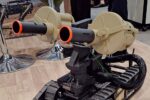Korea Aerospace Industries (KAI) has revealed the first conceptual design of a dedicated electronic warfare (EW) aircraft tailored for the Republic of Korea Air Force (RoKAF). The platform is based on the Gulfstream G550 business jet and aims to significantly boost South Korea’s airborne electronic attack and signals intelligence capabilities. This marks a pivotal step in Seoul’s broader efforts to modernize its C4ISR and EW architecture amid rising regional tensions.
Gulfstream G550 Chosen as Platform Base
The newly unveiled KAI concept is centered around the Gulfstream G550—a high-altitude, long-endurance business jet that has become a favored platform globally for special mission aircraft due to its range (over 12,000 km), ceiling (>15,000 m), and modularity. The G550 is already in use by several nations for ISR and EW roles—including Israel’s Shavit SIGINT version and the U.S. EC-37B Compass Call replacement—making it a logical choice for RoKAF’s future airborne EW fleet.
According to KAI’s renderings presented at Seoul ADEX 2023 and reiterated in September 2025 updates, the proposed aircraft features multiple conformal antennas along the fuselage and underwing pods likely housing active electronically scanned array (AESA) jammers or ELINT/SIGINT payloads. The configuration suggests a multi-role capability encompassing both offensive electronic attack (EA) and passive collection missions.
Program Background: Filling Critical Capability Gaps
The Republic of Korea currently lacks a dedicated airborne electronic attack platform. While it operates some ISR-configured aircraft such as the RC-800 Baekdu (based on Hawker 800), these are primarily focused on signals intelligence rather than jamming or suppression of enemy air defenses (SEAD). In contrast, regional adversaries like China operate advanced EW platforms such as the Shaanxi Y-8G series.
South Korea’s Defense Acquisition Program Administration (DAPA) initiated studies in 2021 into acquiring an indigenous or foreign-supplied airborne EW capability. The goal was to support joint operations with F-35A stealth fighters and indigenous KF-21 Boramae multirole jets by degrading enemy radar networks during high-intensity conflict scenarios. KAI’s unveiling confirms that development has moved into conceptual design phase with clear industrial alignment.
Expected Capabilities: DRFM Jammers and SIGINT Suite
While detailed specifications have not yet been disclosed publicly, open-source analysis of KAI’s mockups combined with known trends in modern EW systems suggest several likely onboard components:
- Digital Radio Frequency Memory (DRFM)-based jammers: For deceptive jamming against fire-control radars.
- AESA-based EA pods: Enabling directional beamforming for stand-off jamming while minimizing collateral interference.
- SIGINT/ELINT suite: Likely including wideband receivers capable of intercepting radar emissions across S-band to Ku-band frequencies.
- C2/Link-16 integration: To ensure real-time data sharing with allied platforms including F-35s and Patriot batteries.
The system may also include automated threat libraries powered by AI algorithms trained on regional emitter databases—similar to what is being fielded aboard U.S. EC-37Bs or Israeli Eitam platforms. This would allow rapid adaptation to evolving radar waveforms during combat operations.
KAI’s Role in System Integration
Korea Aerospace Industries will serve as prime integrator but may rely on foreign partners for key subsystems—especially in high-end electronic warfare payloads. Israel Aerospace Industries (IAI), L3Harris Technologies, or BAE Systems are potential candidates given their experience with similar programs globally. Notably, IAI previously supplied EL/W-2085 AEW&C systems based on G550s to Singapore and Italy.
KAI has not confirmed which foreign vendors it will partner with but stated that “international collaboration” will be essential for meeting operational timelines while preserving domestic IP rights where feasible. Initial development funding was reportedly allocated under DAPA’s mid-term defense plan through FY2026 with prototype rollout targeted around 2027–2028 if contracts are finalized by late 2025.
Strategic Implications Amid Regional Tensions
The unveiling comes amid heightened military activity around the Korean Peninsula and broader Indo-Pacific region. North Korea continues to test new ballistic missile variants—including maneuverable reentry vehicles—and maintains dense SAM coverage around Pyongyang using KN-06 analogues of the Russian S-300 system. An airborne EA platform would be vital in degrading such IADS layers during any preemptive or retaliatory strike campaign.
Moreover, China’s growing A2/AD envelope—anchored by long-range radar networks across Shandong Peninsula and artificial islands in the South China Sea—poses challenges for allied airpower projection. A RoKAF-operated standoff jammer could play an important role in coalition SEAD packages alongside U.S., Japanese or Australian forces under emerging multilateral frameworks like AUKUS Pillar II or ROK-U.S.-Japan trilateral defense cooperation mechanisms.
Comparison With Peer Platforms
If realized as envisioned, RoKAF’s future EW jet would sit alongside platforms such as:
- EC-37B Compass Call II (U.S.): Based on Gulfstream G550; optimized for communications jamming; entering service from FY2024 onward via L3Harris & BAE Systems partnership.
- Eitam CAEW (Israel): Also based on G550; combines AESA radar with SIGINT suite; exported widely including Singapore & Italy.
- Shaaxi Y-9G/YZ-series (China): Larger turboprop-based platforms fielded by PLAAF; carry extensive EA/SIGINT gear but suffer from lower altitude/speed envelopes compared to jets like G550-based systems.
Outlook: From Concept To Capability
KAI’s concept marks a significant milestone toward closing one of RoKAF’s most critical capability gaps—but major hurdles remain before operationalization. These include securing export licenses for sensitive subsystems from allied nations; ensuring electromagnetic compatibility across domestic airspace; training specialized aircrews; and integrating mission data into existing C4ISR networks without latency bottlenecks.
If development proceeds smoothly—with prototype rollout by ~2027—the aircraft could reach IOC before 2030 depending on funding continuity under successive administrations. Given South Korea’s increasing emphasis on strategic autonomy while maintaining interoperability with U.S.-led command structures, this program may become central not only tactically but also diplomatically within Asia-Pacific security architecture over coming decades.









